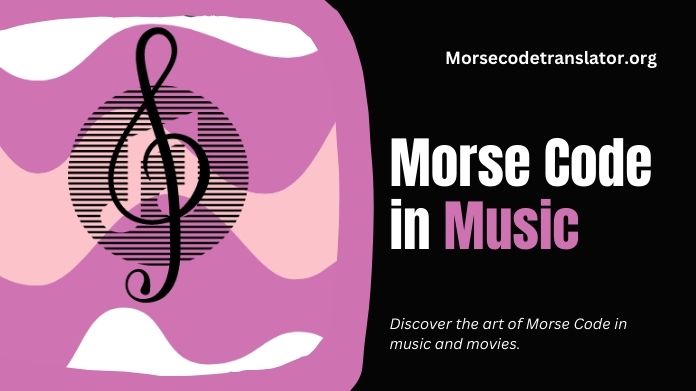In the intricate tapestry of music and movies, creators often embed cryptic elements, adding intrigue for those attuned to subtle nuances.
Morse Code in music, a communication system dating back to the 19th century, has transcended its original telegraphic purpose, finding an unexpected and captivating home in entertainment.
This Morse Code Translator article delves into the fascinating synergy between Morse Code in music and the creative arts. It explores how musicians and filmmakers employ this age-old code to conceal messages within their works’ auditory and visual landscapes.
Join us on a journey where every dot and dash becomes a portal to hidden meanings waiting to be deciphered by keen observers.
What is Morse Code?
Morse Code is a text encoding system that uses a series of dots and dashes to represent punctuation, numbers, and letters. Samuel Morse and Alfred Vail created it in the 1830s and 1840s to communicate over large distances by telegraph.
In Morse Code, each letter and numeral is assigned a unique combination of short signals (dots) and long signals (dashes), often referred to as “dots and dashes” or “dits and dahs.”
The code is characterized by simplicity and efficiency, with more frequent letters assigned shorter codes to optimize transmission speed. Morse Code has been widely used in various applications, from early telegraph communication to maritime and aviation signaling.
While its original purpose was practical, Morse Code also found creative applications, such as encoding messages in music and movies and communicating in specific niche communities.
Despite technological advancements, Morse Code retains historical significance and is still learned and used by enthusiasts today.
Morse Code in Music and Movies

Morse Code, a communication method born out of telegraphy’s necessity, has transcended its utilitarian origins, finding a captivating niche Morse code in music and movies.
Once confined to telegraph wires, the rhythmic arrangement of dots and dashes has become a subtle and creative language within entertainment’s auditory and visual landscapes.
Music’s Morse-ful Rhythms
In the realm of music, Morse Code offers composers a unique palette for embedding hidden messages. Artists infuse their compositions with a cryptic layer by translating dots and dashes into rhythmic patterns or musical notes.
From progressive rock bands like Rush incorporating Morse Code in “YYZ” to more subtle integrations in various genres, decoding these auditory enigmas adds an extra dimension for attentive listeners.
Cinematic Secrets Encoded
In the realm of cinema, Morse Code takes on a visual allure. Filmmakers strategically weave these coded signals into scenes or soundtracks, adding layers of meaning that may elude casual viewers.
Whether conveying covert messages pivotal to the plot or serving as an Easter egg for observant audiences, Morse Code in movies transforms storytelling into a puzzle to be solved.
Notable Instances and Cultural Impact
Iconic instances linger in popular culture, showcasing Morse Code’s artistic integration. In Disney’s “Dumbo” (1941), the titular character’s animated ears move in Morse Code to spell “E-A-R,” a clever nod to the character’s defining feature.
Television series like “Stranger Things” leverage Morse Code as a thematic element, fostering a sense of mystery and communication between characters.
The Artistic Tapestry
Morse Code’s incorporation into music and movies goes beyond mere novelty; it becomes a form of artistic expression, a secret language shared between creators and their audiences.
It transforms passive consumption into an interactive experience, where enthusiasts delight in decoding hidden messages, creating a unique connection with the work of art.
The Enduring Allure
Despite technological advancements, the allure of the Morse Code persists. Its timeless grace and simplicity make it a versatile tool for artists seeking to infuse their creations with an extra layer of depth as audiences continue to explore the multifaceted realms of music and movies, the dots and dashes of Morse Code beckon, inviting us to unravel the enigma encoded within the symphony of sound and the play of light on the silver screen.
Conclusion
As we uncover the hidden meanings, we’re not just solving a puzzle but joining a particular conversation between the creators and us. Morse Code, once a severe way to send messages, now adds a touch of mystery to the joy of music and movies.
It’s like finding secret notes in a symphony or spotting hidden signals in a film—a silent language that makes the whole experience even more exciting.
So, as we enjoy the Morse Code magic in our favorite tunes and movies, we’re part of a fantastic club that speaks the language of dots and dashes.
